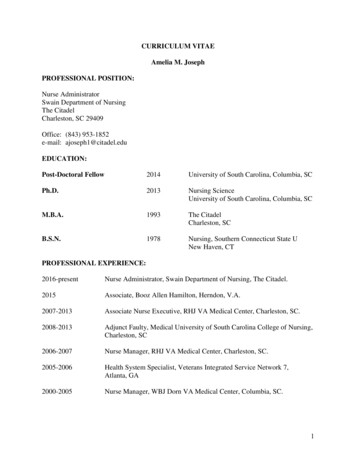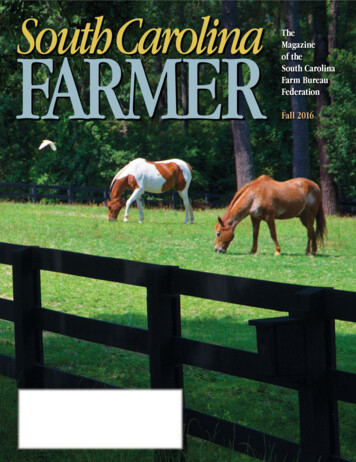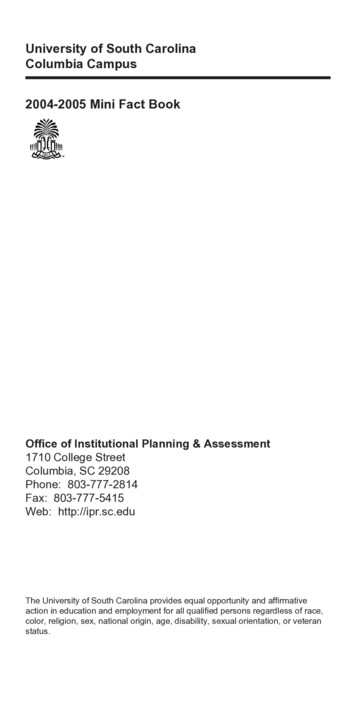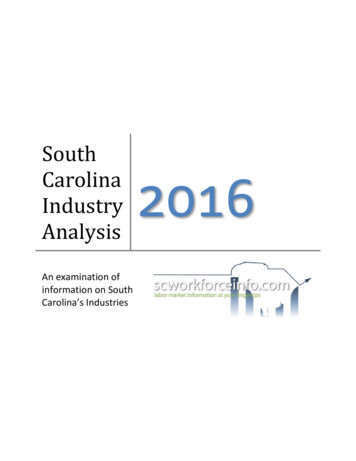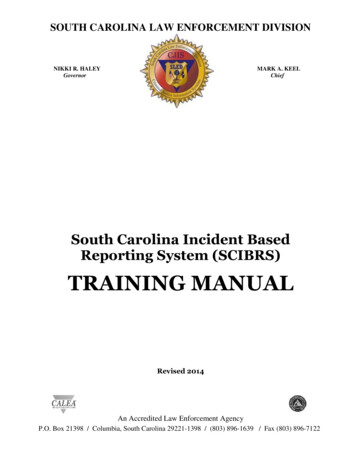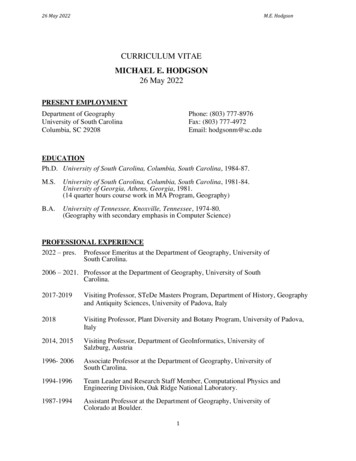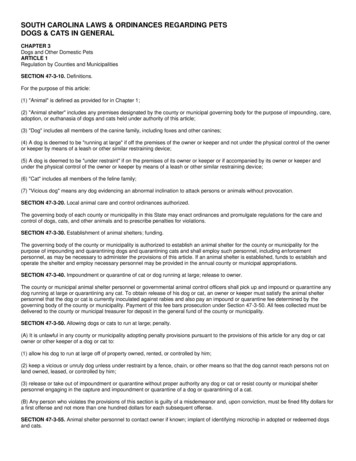
Transcription
SOUTH CAROLINA LAWS & ORDINANCES REGARDING PETSDOGS & CATS IN GENERALCHAPTER 3Dogs and Other Domestic PetsARTICLE 1Regulation by Counties and MunicipalitiesSECTION 47-3-10. Definitions.For the purpose of this article:(1) "Animal" is defined as provided for in Chapter 1;(2) "Animal shelter" includes any premises designated by the county or municipal governing body for the purpose of impounding, care,adoption, or euthanasia of dogs and cats held under authority of this article;(3) "Dog" includes all members of the canine family, including foxes and other canines;(4) A dog is deemed to be "running at large" if off the premises of the owner or keeper and not under the physical control of the owneror keeper by means of a leash or other similar restraining device;(5) A dog is deemed to be "under restraint" if on the premises of its owner or keeper or if accompanied by its owner or keeper andunder the physical control of the owner or keeper by means of a leash or other similar restraining device;(6) "Cat" includes all members of the feline family;(7) "Vicious dog" means any dog evidencing an abnormal inclination to attack persons or animals without provocation.SECTION 47-3-20. Local animal care and control ordinances authorized.The governing body of each county or municipality in this State may enact ordinances and promulgate regulations for the care andcontrol of dogs, cats, and other animals and to prescribe penalties for violations.SECTION 47-3-30. Establishment of animal shelters; funding.The governing body of the county or municipality is authorized to establish an animal shelter for the county or municipality for thepurpose of impounding and quarantining dogs and quarantining cats and shall employ such personnel, including enforcementpersonnel, as may be necessary to administer the provisions of this article. If an animal shelter is established, funds to establish andoperate the shelter and employ necessary personnel may be provided in the annual county or municipal appropriations.SECTION 47-3-40. Impoundment or quarantine of cat or dog running at large; release to owner.The county or municipal animal shelter personnel or governmental animal control officers shall pick up and impound or quarantine anydog running at large or quarantining any cat. To obtain release of his dog or cat, an owner or keeper must satisfy the animal shelterpersonnel that the dog or cat is currently inoculated against rabies and also pay an impound or quarantine fee determined by thegoverning body of the county or municipality. Payment of this fee bars prosecution under Section 47-3-50. All fees collected must bedelivered to the county or municipal treasurer for deposit in the general fund of the county or municipality.SECTION 47-3-50. Allowing dogs or cats to run at large; penalty.(A) It is unlawful in any county or municipality adopting penalty provisions pursuant to the provisions of this article for any dog or catowner or other keeper of a dog or cat to:(1) allow his dog to run at large off of property owned, rented, or controlled by him;(2) keep a vicious or unruly dog unless under restraint by a fence, chain, or other means so that the dog cannot reach persons not onland owned, leased, or controlled by him;(3) release or take out of impoundment or quarantine without proper authority any dog or cat or resist county or municipal shelterpersonnel engaging in the capture and impoundment or quarantine of a dog or quarantining of a cat.(B) Any person who violates the provisions of this section is guilty of a misdemeanor and, upon conviction, must be fined fifty dollars fora first offense and not more than one hundred dollars for each subsequent offense.SECTION 47-3-55. Animal shelter personnel to contact owner if known; implant of identifying microchip in adopted or redeemed dogsand cats.
(A) If an animal shelter accepts or comes into possession of a dog or cat, the shelter immediately and thoroughly must scan the dog orcat for a tatoo, any implanted microchip, or similar device, which provides evidence of ownership and, upon finding it, immediately mustmake a good faith effort to contact the identified owner as required by Section 47-3-540.(B) If an animal shelter or its officers, directors, or staff have made a good faith effort to comply with the provisions of subsection (A),they must be held harmless, as well as the manufacturer, against any action at law or otherwise, civil or criminal, for failure to detect amicrochip or similar device and undertake the action specified in subsection (A).(C) If a dog or cat is adopted or redeemed from an animal shelter, a licensed veterinarian or an animal shelter employee under thedirection of a licensed veterinarian may implant a microchip in the dog or cat adopted or redeemed. The animal shelter shall record thedate the microchip was implanted, the name, address, and telephone number of the person adopting or redeeming the dog or cat, anidentification number unique to the dog or cat adopted or redeemed, the name, address, and telephone number of the animal shelterthat sheltered the dog or cat before adoption or redemption, and the date the dog or cat was adopted or redeemed. The animal sheltermust keep a record of all microchips implanted pursuant to this subsection.(D) The animal shelter is not required to adhere to subsection (A), if the necessary scanner is not provided free of charge or at areasonable cost as determined by the county or municipality.(E) The owner redeeming his dog or cat must elect to have a microchip implanted.SECTION 47-3-60. Disposition of quarantined or impounded animals.(A) After any animal has been quarantined pursuant to South Carolina Rabies Control Act and is unclaimed by its owner, after theanimal shelter employees have made a good faith effort to contact the identified owner as required by Section 47-3-540, the animalshelter employees, unless the animal must be kept pending disposition of a criminal or civil trial involving the animal or unless a hearingon the disposition of the animal is held prior to the trial, may dispose of the animal by adoption or by euthanasia or the animal may beturned over to any organization established for the purpose of caring for animals, such as the Humane Society.(B) After any animal has been impounded for five days and is unclaimed by its owner, and after the animal shelter employees havemade a good faith effort to contact the identified owner as required by Section 47-3-540, the animal shelter employees, unless theanimal must be kept pending disposition of a criminal or civil trial involving the animal or unless a hearing on the disposition of theanimal is held prior to the trial, may dispose of the animal by adoption or by euthanasia or the animal may be turned over to anyorganization established for the purpose of caring for animals, such as the Humane Society.(C) Complete records must be kept by shelter officials as to the disposition of all animals impounded.SECTION 47-3-70. County and municipal powers not limited by article.Nothing in this article may be construed to limit the power of any municipality or county to prohibit animals from running at large,whether or not they have been inoculated as provided in this article; and nothing in this article may be construed as to limit the power ofany municipality or county to regulate and control further in the county or municipality to enforce other and additional measures for therestriction and control of rabies.SECTION 47-3-75. Transfer of domestic animal to animal shelter ten days after date owner was to pick up animal; requirements.(A) An animal delivered to a veterinarian, a dog kennel, a cat kennel, an animal hospital, another animal care facility, or to a person whoboards domestic animals on the person's premises for a fee may be transferred to an appropriate animal shelter ten days after the datethe owner failed to pick up the animal as agreed to pursuant to a written contract or agreement. The animal may be transferred only ifthe written contract or agreement provides for the transfer and if an attempt is made to notify the owner by regular mail and by certifiedmail at the owner's last known address on the date the owner failed to pick up the animal as agreed.(B) A person who boards animals of others pursuant to subsection (A) shall post written notice of the provisions of this section at theperson's place of business.(C) A person who fails to pick up an animal as provided for in subsection (A), who fails to pay his boarding fees in a timely manner, orwho abandons an animal at an animal hospital, a dog kennel, a cat kennel, another animal care facility, or boarding facility is guilty of amisdemeanor and, upon conviction, may be imprisoned not more than thirty days or fined not more than two hundred dollars.ARTICLE 2Liability to Person Bitten or Otherwise Attacked by DogSECTION 47-3-110. Liability for attacks by dogs, provoked attacks, trained law enforcement dogs.(A) If a person is bitten or otherwise attacked by a dog while the person is in a public place or is lawfully in a private place, including theproperty of the dog owner or person having the dog in the person's care or keeping, the dog owner or person having the dog in theperson's care or keeping is liable for the damages suffered by the person bitten or otherwise attacked. For the purposes of this section,a person bitten or otherwise attacked is lawfully in a private place, including the property of the dog owner or person having the dog inthe person's care or keeping, when the person bitten or otherwise attacked is on the property in the performance of a duty imposed
upon the person by the laws of this State, the ordinances of a political subdivision of this State, the laws of the United States of Americaincluding, but not limited to, postal regulations, or when the person bitten or otherwise attacked is on the property upon the invitation,express or implied, of the property owner or a lawful tenant or resident of the property.(B) This section does not apply if, at the time the person is bitten or otherwise attacked:(1) the person who was attacked provoked or harassed the dog and that provocation was the proximate cause of the attack; or(2) the dog was working in a law enforcement capacity with a governmental agency and in the performance of the dog's official dutiesprovided that:(a) the dog's attack is in direct and complete compliance with the lawful command of a duly certified canine officer;(b) the dog is trained and certified according to the standards adopted by the South Carolina Law Enforcement Training Council;(c) the governmental agency has adopted a written policy on the necessary and appropriate use of dogs in the dog's official lawenforcement duties;(d) the actions of the dog's handler or dog do not violate the agency's written policy;(e) the actions of the dog's handler or dog do not constitute excessive force; and(f) the attack or bite does not occur on a third party bystander.ARTICLE 3Sheep-Killing DogsSECTION 47-3-210. Keeping of sheep-killing dog prohibited.No persons shall buy, sell, receive, give away or otherwise own, control, have or keep in possession any dog commonly called "sheepkilling" and known to be such. The violation, knowingly, in any one or all respects of the foregoing prohibition shall be a misdemeanorpunishable, upon conviction, by a fine not exceeding one hundred dollars or imprisonment for not exceeding thirty days.SECTION 47-3-220. Dog found in act of worrying or destroying sheep may be killed.Any person who may find any dog in the act of worrying or destroying any sheep in this State may kill such dog and such person shallnot for so doing be held to answer to any action, civil or criminal.SECTION 47-3-230. Liability of owner of sheep-killing dog for payment to owner of sheep killed or injured.The owner of or person having in his care or keeping any dog shall be liable to pay to the person damaged double the value of anysheep that may be killed or injured by such dog, to be recovered by action at the suit of the person damaged in any court havingcompetent jurisdiction. In all such actions the recovery of ten dollars or more shall carry costs.ARTICLE 5Feral DogsSECTION 47-3-310. Disposal or removal of feral dogs from certain property.On game management areas, state-owned property and property of private landowners and leaseholders, at the request of suchlandowners and leaseholders, specially trained enforcement officers of the Natural Resources Enforcement Division of the Departmentof Natural Resources may enter on such areas and property for the purpose of investigating dogs running at large on the property. If thedogs are determined to be feral dogs (a dog which has reverted to a wild state) and are a threat to the lives or health of livestock,wildlife or humans, the enforcement officers may remove the feral dog from the property or dispose of it in the most humane manner asdetermined by the department.SECTION 47-3-320. Training of conservation officers to remove dogs; liability of officers.Two enforcement officers of the Natural Resources Enforcement Division of the Department of Natural Resources from each of thestate's twenty-eight law enforcement units shall be trained by the Department in the identification, capture and humane disposal of feraldogs and these officers shall have the responsibility of answering all complaints concerning feral dogs within the geographicalboundaries of their respective law enforcement units. Such enforcement officers shall be held harmless of any personal liability thatmay occur during the lawful execution of their duties under this act except in case of gross negligence.ARTICLE 7Animal Euthanasia and Tranquilization
SECTION 47-3-410. Animal shelter defined.The term "animal shelter" means any place or premises kept for the care, keeping, impounding, housing or boarding of any animal,whether the premises are owned or operated by a municipality, county, private association, institution, humane organization, or anyother business or corporation.SECTION 47-3-420. Allowable methods of euthanasia.(A) Only the following methods of euthanasia may be used to kill animals impounded or quarantined in animal shelters, and theprocedure applicable to the method selected must be strictly followed:(1) Barbituric acid derivatives:(a) intravenous or intracardial injection of a lethal solution;(b) intraperitoneal injection of lethal solution when location of an injection into the vein is difficult or impossible;(c) oral ingestion of powdered barbituric acid derivatives in capsules mixed with food or by manual administration of a solution;(d) intravenous injection of these solutions must be specifically injected according to the directions of the manufacturers for intravenousinjections;(e) intracardial injection of these solutions must only be administered if the animal has been tranquilized with an approved, humanesubstance and the animal, at the time of the intracardial injection, is anesthetized or comatose;(f) the solutions may not be administered via intraperitoneal, intrathoracic, intrapulmonary, subcutaneous, intramuscular, intrarenal,intrasplenic, or intrathecal routes or in any other nonvascular injection route except as provided above;(g) administration of injections must be done only by a licensed veterinarian or by a euthanasia technician or Department of NaturalResources employee, trained and certified for this purpose in a euthanasia training class taught by a licensed South Carolinaveterinarian, which must include training in tranquilizing animals. A person certified pursuant to this subitem must continue to maintainhis proficiency by successfully completing a training course taught by a licensed South Carolina veterinarian every five years;(h) all injections must be administered using an undamaged hypodermic needle of a size suitable for the size and species of animal;(i) an animal shelter, governmental animal control agency, or the Department of Natural Resources (department) may obtain abarbituric acid derivative or tranquilizing agent by direct licensing. The animal shelter, governmental animal control agency, ordepartment must apply for a Controlled Substance Registration Certificate from the federal Drug Enforcement Administration (DEA) anda State Controlled Substances Registration from the Department of Health and Environmental Control (DHEC). If an animal shelter,governmental animal control agency, or the department is issued a certificate by the DEA and a registration by DHEC pursuant to thissubitem, the animal shelter, governmental animal control agency director or his designee, and the department's applicant areresponsible, for maintaining their respective records regarding the inventory, storage, and administration of controlled substances. Ananimal shelter, governmental animal control agency and its certified euthanasia technician, and the department and its certifiedemployees are subject to inspection and audit by DHEC and the DEA regarding the recordkeeping, inventory, storage, andadministration of controlled substances used under authority of this article.(2) Carbon monoxide gas:(a) dogs and cats, except animals under sixteen weeks of age, may be killed by bottled carbon monoxide gas administered in a tightlyenclosed chamber. The chamber must be equipped with:(i) internal lighting and a window providing direct visual surveillance of the collapse and death of any animal within the chamber;(ii) the gas concentration process must be adequate to achieve a carbon monoxide gas concentration throughout the chamber of atleast six percent within five minutes after any animal is placed in the chamber. The chamber must have a functioning gas concentrationgauge attached to the chamber and a strong airtight seal must be maintained around the door;(iii) the unit shall include an exhaust fan connected by a gas-tight duct to the outdoors capable of completely evacuating the gas fromthe chamber before it is opened after each use, except that this provision does not apply to chambers located out-of-doors;(iv) animals must be left in the chamber for a period of no less than fifteen minutes from the time the gas concentration throughout thechamber reaches six percent.(b) no person may euthanize an animal by gas emitted from any engine exhaust system.(c) in all instances where a carbon monoxide chamber is used:(i) no incompatible or hostile animals, or animals of different species, may be placed in any chamber simultaneously;
(ii) every chamber must be thoroughly cleaned after the completion of each full cycle. No live animals may be placed in the chamberwith dead animals;(iii) all animals must be examined by a veterinarian or certified euthanasia technician to ensure they are dead upon removal from thechamber;(iv) all chambers must be inspected quarterly by an independent, qualified technician who is thoroughly knowledgeable with theoperation and maintenance of the particular euthanasia chamber being used;(v) an operational guide and maintenance instructions must be displayed in the room with the euthanasia chamber.(3) Shooting:Shooting may be used as a means of euthanasia only in an emergency situation to prevent extreme suffering or in which the safety ofpeople or other animal life is threatened or where it is considered necessary by the South Carolina Department of Natural Resources toeliminate or control the population of feral animals.(B) In any of the previously listed methods, an animal may not be left unattended between the time euthanasia procedures havecommenced and the time death occurs, and the animal's body may not be disposed of until death is confirmed by a certified euthanasiatechnician.SECTION 47-3-430. Provision governing shelters.All animal shelters are subject to the provisions of Chapter 1 of Title 47.SECTION 47-3-440. Penalties; injunction.No person may kill any animal impounded or quarantined in an animal shelter by any means except as provided by this article. Anyperson who violates the provisions of this article is guilty of a misdemeanor and, upon conviction, is subject to the penalty provisions inChapter 1, Title 47 for each animal killed. The Attorney General of South Carolina may bring an action to enjoin a violation of thisarticle.SECTION 47-3-450. Exceptions.The provisions of this article do not apply to persons engaged in scientific endeavors by institutions of higher education.ARTICLE 8Sterilization of Dogs and CatsSECTION 47-3-470. Descriptions.As used in this article:(1) "Animal Shelter" means:(a) a facility operated by or under contract for the State or a county, a municipal corporation, or other political subdivision of the Statefor the purpose of impounding or harboring seized, stray, homeless, abandoned, or unwanted dogs, cats, and other animals;(b) a veterinary hospital or clinic operated by a veterinarian or veterinarians which operates for the purpose set forth in subitem (a) inaddition to its customary purposes;(c) a facility operated, owned, or maintained by an incorporated humane society, animal welfare society, or other nonprofit organizationfor the purpose of providing for and promoting the welfare, protection, and humane treatment of animals.(2) "Humane society" means an unincorporated nonprofit organization existing for the purpose of prevention of cruelty to animals.(3) "Public or private animal refuge" means harborers of unwanted animals of any breed, including crossbreeds, who provide food,shelter, and confinement for a group of dogs, a group of cats, or a combination of dogs and cats.(4) "Sexually mature animal" means a dog or cat that has reached the age of one hundred eighty days or six months or more.(5) "Sterilization" means the surgical removal of the reproductive organs of a dog or cat in order to render the animal unable toreproduce.SECTION 47-3-480. Provisions for sterilization; exceptions; payment of costs; subsequent notification of sterilization for animals notsterile when acquired.
(A) A public or private animal shelter, animal control agency operated by a political subdivision of this State, humane society, or publicor private animal refuge shall make provisions for the sterilization of all dogs or cats acquired from the shelter, agency, society, orrefuge by:(1) providing sterilization by a licensed veterinarian before relinquishing custody of the animal; or(2) entering into a written agreement with the person acquiring the animal guaranteeing that sterilization will be performed by a licensedveterinarian within thirty days after acquisition of a sexually mature animal or no later than six months of age except upon a writtenstatement issued by a licensed veterinarian stating that such surgery would threaten the life of the animal.(B) This section does not apply to a privately owned animal which the shelter, agency, society, or refuge may have in its possession forany reason if the owner of the animal claims or presents evidence that the animal is his property.(C) All costs of sterilization pursuant to this section are the responsibility of the person acquiring the animal and, if performed beforeacquisition, may be included in the fees charged by the shelter, agency, society, or refuge for the animal.(D) A person acquiring an animal from a shelter, an agency, a society, or a refuge which is not sterile at the time of acquisition shallsubmit to the shelter, agency, society, or refuge a signed statement from the licensed veterinarian performing the sterilization requiredby subsection (A) within seven days after sterilization attesting that the sterilization has been performed.SECTION 47-3-490. Failure to comply; remedies.A person who fails to comply with Section 47-3-480(A)(2) or 47-3-480(D) must forfeit ownership of the dog(s) or cat(s) acquired fromthe shelter, agency, society, or refuge which adopted the animal to the owner. In addition to forfeiting ownership, the person whoacquired the animal must pay to the shelter, agency, society, or refuge the sum of 200.00 as liquidated damages. Such remedies shallbe in addition to any other legal or equitable remedies as may be available to the shelter, agency, society, or refuge for breach of thewritten agreement as provided for in Section 47-3-480(A)(2) or failure to comply with Section 47-3-480(D).SECTION 47-3-500. Adoption of additional policies by other entities.This article does not prohibit the adoption by a political subdivision of this State of shelter policies which are more stringent than therequirements of this article.ARTICLE 9Registration of DogsSECTION 47-3-510. Owner may register dog; fee.The owner of any dog or kennel may, upon payment of a fee to be determined by the South Carolina Department of Natural Resources(department), not to exceed five dollars a dog or twenty dollars a kennel, have his dog registered by the department and the registrationnumber tattooed in either of the dog's ears or on any other clearly visible part of the body that would be considered most suitable for therespective species of dog. The department shall maintain records of the names and addresses of the owners of registered kennels.SECTION 47-3-520. Availability of registration file.The department shall have this file available for county, city, or subdivision animal control agencies or departments and individuals. Theentire cost must be assessed upon dog owners in registration fees.SECTION 47-3-530. Penalties for stealing or killing identifiable dog.Any person stealing any positively identifiable dog is guilty of a misdemeanor and upon conviction must be fined not less than fivehundred dollars nor more than one thousand dollars or imprisoned for not less than thirty days nor more than six months, or both.Any person killing any dog when owner may be identified by means of a collar bearing sufficient information or some other form ofpositive identification is guilty of a misdemeanor and upon conviction must be fined not less than five hundred dollars nor more than onethousand dollars or imprisoned for not less than thirty days nor more than six months, or both. This paragraph does not apply to thekilling of a dog threatening to cause or causing personal injury or property damage.SECTION 47-3-540. Destruction of identifiable dog by animal control officer; prior notification of owner.Animal control officers must not destroy any positively identifiable dog until they have notified the owner at his last known address byregistered mail that they have the dog in their possession. The owner must notify the animal control officer within two weeks that he willpick up his dog. If the owner does not pick up his dog within two weeks of notification to the animal control officer, the dog may bedestroyed. Reasonable costs associated with the above extended holding period, including cost of mailing the required notice, must bepaid before the dog is returned to its owner, or the owner's designee, in addition to any other established costs, fines, fees, or othercharges.SECTION 47-3-550. Promulgation of regulations.
The South Carolina Department of Natural Resources may promulgate regulations to carry out the provisions of this chapter.ARTICLE 11Teasing, Maltreating, and Injuring Police Dogs ProhibitedSECTION 47-3-610. Unlawful to taunt, torment, tease, beat, strike, or administer desensitizing drug to police dog or horse.It is unlawful for a person to wilfully and maliciously taunt, torment, tease, beat, strike, or administer or subject a desensitizing drug,chemical, or substance to a dog or horse used by a law enforcement department or agency in the performance of the functions orduties of the department or agency or when a dog is placed in a kennel off duty or a horse is placed in a stable off duty, or to interfereor meddle with a dog or horse used by a law enforcement department or agency in the performance of the functions or duties of thedepartment or agency.SECTION 47-3-620. Unlawful to torture, mutilate, injure, disable, poison, or kill police dog or horse.It is unlawful for a person to wilfully or maliciously torture, mutilate, injure, disable, poison, or kill a dog or horse used by a lawenforcement department or agency in the performance of the functions or duties of the department or when a dog is placed in a kenneloff duty or a horse is placed in a stable off duty. However, a police officer or veterinarian may perform euthanasia in emergencysituations when delay would cause the dog or horse undue suffering and pain.SECTION 47-3-630. Penalties.A person who violates any of the provisions of this article, except for Section 47-3-620, is guilty of a misdemeanor and, upon conviction,must be fined not less than five hundred dollars nor more than one thousand dollars or imprisoned not less than thirty days nor morethan six months, or both. A person who violates the provisions of Section 47-3-620 is guilty of a felony and, upon conviction, must befined not less than two thousand dollars nor more than five thousand dollars and imprisoned not less than one year nor more than fiveyears.ARTICLE 13Regulation of Dangerous AnimalsSECTION 47-3-710. Definitions.(A) As used in this article "dangerous animal" means an animal of the canine or feline family:(1) which the owner knows or reasonably should know has a propensity, tendency, or disposition to attack unprovoked, cause injury, orotherwise endanger the safety of human beings or domestic animals;(2) which:(a) makes an unprovoked attack that causes bodily injury to a human being and the attack occurs in a place other than the place wherethe animal is confined as required by Section 47-3-720; or(b) commits unprovoked acts in a place other than the place where the animal is confined as required by Section 47-3-720 and thoseacts cause a person to reasonably believe that the animal will attack and cause bodily injury to a human being;(3) which is owned or harbored primarily or in part for the purpose
Local animal care and control ordinances authorized. The governing body of each county or municipality in this State may enact ordinances and promulgate regulations for the care and control of dogs, cats, and other animals and to prescribe penalties for violations. SECTION 47-3-30. Establishment of animal shelters; funding.
